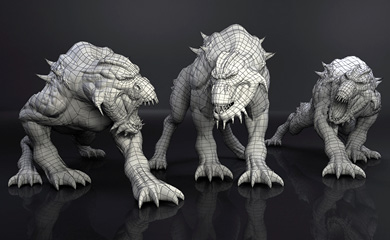 3D Modeling should be understood as an operation of creating a comprehensive mathematical model of some object or surface. Nowadays there is a large amount of various modeling techniques that greatly improve the modeling process. Today’s article 3D-Ace decided to dedicate to the review of standard methods that 3D artists use in order to develop three-dimensional prototypes from technical plus artistic sides.
3D Modeling should be understood as an operation of creating a comprehensive mathematical model of some object or surface. Nowadays there is a large amount of various modeling techniques that greatly improve the modeling process. Today’s article 3D-Ace decided to dedicate to the review of standard methods that 3D artists use in order to develop three-dimensional prototypes from technical plus artistic sides.
Subdivision Modeling (Box Modeling)
Subdivision Modeling is one of the most trivial 3D methods. It’s basically a polygonal method when 3D artists take a simple geometric shape as a basis, for example, sphere, parallelepiped, cone, cube and other items. After that, they purify and improve the shape just before they reach the desired form of an object.
Artists that use such technique frequently divide their work into stages. First, they took a low-resolution mesh as an essential element, and then a 3D master improves the shape of an item to make it close to the one he imagines it to be. Finally, an artist makes the mesh smaller to make acute sharpen edges smoother and accumulate more details to the figure. The process can be repeated as many times as necessary to create a correct polygonal interpretation of a desired concept.
Contour Modeling (Edge Modeling)
Unlike the modeling type we mentioned before where a user should develop a simple model, edge modeling supports the concept that 3D models should be created element by element by placing loops on facets and occupy spaces between gaps.
This technique is rather difficult, however, it helps artists to create more detailed and well-legible models. Besides, 3D professionals often combine edge and box modeling since it could sometimes be hard to achieve desired results by using box method only. For instance, a face of a human or a muzzle of an animal or a creature are extremely challenging to model. To construct them properly and fast an artist should first define dominating exterior features like eyes, nose, ears, lips, etc., and then model remaining aspects of an appearance.
Spline Modeling (NURBS)
This method is primarily used in industrial, mechanical and automobile 3D modeling. The mesh of the model is smooth and formed by moving of surfaces between a number of so-called splines. Such technique becomes an industry standard for radial objects, for example, various vessels, dishes, etc.
Digital Sculpting
This technique allows artists to create meshes manually with help of a tablet and model characters and antiheroes, animals and various creatures with sculptural accuracy. Digital sculpting makes modeling more rapid and effective. Besides, an artist can perform his job using its facilities and creating millions of polygons.
Procedural Modeling
This method refers to 3D models that were created automatically, not manually, according to user-defined parameters. This kind of modeling commonly applies to the creation of assets that tend to change constantly, for example, trees and their leaves. The process of modeling such objects with limitless modifications is almost beyond the bound of possibility and labour-intensive, as well. That’s why a number of applications like SpeedTree use algorithms to accumulate unique objects that can be edited using hundreds of parameters like color, height, angle, etc.
Image-Based Modeling
This method represents conversion and transformation of a set of 2D pictures into a comprehensive 3D object. Such modeling usually finds its applying in cases when there are no much time or money for manual 3D production. The greatest and almost legendary example of an image-based technique is, of course, ‘The Matrix’ movie when the scene was filmed using 360-degree equipment, and then 3D artists generated a ‘virtual camera’ tool to make it look 3D realistic.
Scanning
The 3D skimming technique is basically a transfer of an existing object into a digital system with photo-realistic accuracy. As soon as a subject or an object are scanned, computer analyzes gathered information and generates a polygonal mesh. In filming industry, 3D scanning can be applied when it is necessary to have a computer model of an actor because of a screenplay details (for example, Brad Pitt in ‘The Curious Case of Benjamin Button’), an unexpected death of an artist before the end of the movie (Philip Seymour Hoffman in ‘The Hunger Games: Mockingjay – Part 2’), etc.
Conclusion
Various modeling techniques we introduced above represent the most common methods for photo-realistic 3D object creation and firmly occupy the gap of their activity. The method for the specific project should be chosen according to the strategy requirements.
3D-Ace is an expert team with strong knowledge and considerable experience in 3D modeling methods listed above and can deliver featured and out-of-the-box solutions for various projects of our clients. With the help of artists of our 3D modeling company the customer can create a game or a movie with monsters, aliens, film and cartoon characters and assets. You can take a closer look at them in our portfolio. We are ready to implement any idea leaving the limits of the possible.









